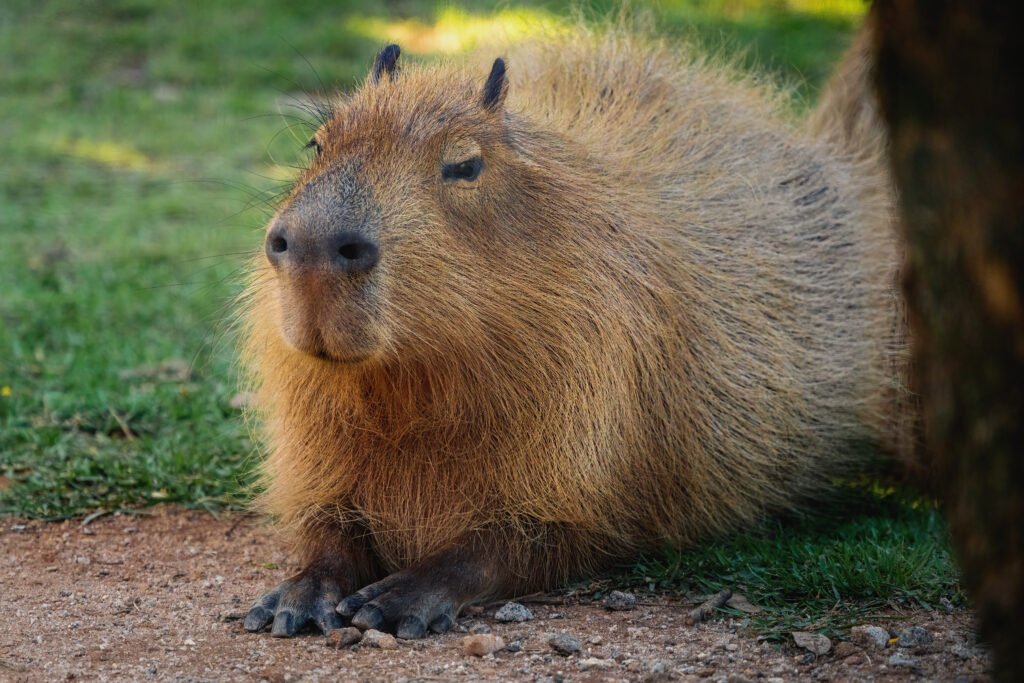The Capybaras communicate with sound
Updated August 8, 2025
Capybaras have become a symbol of tranquility, but behind that calm exterior lies a complex and chatty world. Far from being silent, these gentle giants have a rich capybara noise repertoire, using a wide range of vocalizations to communicate with their group members. Their unique vocalizations are not just random sounds; they are essential for their survival, social cohesion, and the maintenance of their herd’s well-being.
In this deep dive, we’ll uncover the fascinating ways capybaras communicate with sound, exploring everything from their distinct alarm barks to their subtle purrs. We’ll also touch on how their communication goes beyond sound, showcasing why the capybara animal is one of the most sophisticated social creatures in the animal kingdom.
The Capybara’s Vocal Repertoire
The “chill” reputation of the capybara on social media often hides the fact that they are quite vocal. Every sound they make serves a purpose, whether it’s to warn of danger, express affection, or simply keep in touch with their herd.
The Alarm Bark: A Sound of Urgency
Perhaps the most dramatic sound a capybara makes is its alarm bark. When a capybara senses a predator, such as a jaguar or a caiman, it will emit a sharp, loud bark that sounds remarkably like a dog. This is not a casual sound; it’s a vital warning call that immediately alerts the entire group to a potential threat. Upon hearing the bark, the herd will swiftly rush into the nearest body of water, their primary defense mechanism. This vocalization is a perfect example of how their sounds are directly tied to their survival and social cohesion in the wild.
Purrs, Whistles, and Clicks: The Sounds of a Social Life
Not all capybara noises are about danger. They also have a range of sounds for everyday social interactions. A contented capybara, especially when being groomed by a fellow group member, will often produce a low, purr-like sound. This is a clear indicator of relaxation and comfort, much like a cat’s purr.
They also communicate through clicks and whistles. Clicks are a versatile form of communication, used to keep the group together while foraging or moving. Research has shown that these clicks can even have a “vocal signature” unique to a specific herd, allowing them to recognize their own group from others. Whistling is often a sign of a female in estrus, as it is a way to signal to males that she is ready to mate. This subtle communication helps to manage social dynamics and reproductive activities within the group.
Grunts and Chattering: Everyday Communication
Beyond the more distinct sounds, capybaras have a rich vocabulary of grunts, mutters, and chattering. These sounds are used for general communication, expressing curiosity, or simply maintaining contact within the herd. A mother might use gentle grunts to communicate with her capybara baby, while a male might chatter to another during a minor dispute over food. These constant, low-volume communications are the background noise of a capybara’s social life, reinforcing bonds and maintaining harmony.
The Secret Language of Scent
While their vocalizations are fascinating, a capybara’s communication isn’t limited to sound. They also have a sophisticated system of scent marking that plays a critical role in social dynamics, particularly for male capybaras. This is a capybara fun fact that a lot of people don’t know about.

The Morillo Gland: A Scented Signal
On the top of a male’s snout is a large, dark, hairless patch called the morillo. This is a specialized scent gland that secretes an oily, waxy substance. Males rub this gland on vegetation and trees to leave a unique “chemical fingerprint” that communicates their status to other capybaras. The size of the morillo is often a sign of a male’s age and social dominance; dominant males have a larger morillo and mark their territory more frequently than their subordinates. This scent marking is crucial for establishing and maintaining a social hierarchy and is a key part of courtship rituals.
Anal Glands: Marking Identity and Territory
Both male and female capybaras also possess anal glands that they use to mark territory. By dragging these glands along the ground or vegetation, they leave behind a unique scent that helps other group members identify them and reinforces the boundaries of their territory. This scent communication is vital for keeping the herd cohesive and for defining their capybara habitat.
Communication in the Wild and in Captivity
The communication methods of capybaras are a direct reflection of their lives as highly social, semi-aquatic animals. In their capybara habitat, a complex system of sounds and scents allows them to coordinate group movements, avoid predators, and successfully reproduce. This is a prime example of their adaptability and intelligence.
For those interested in a capybara as a pet, understanding their vocalizations and scent-marking behaviors is crucial. Their sounds, far from being just cute capybara noise, are a window into their emotional state and needs. A quiet capybara is not necessarily a happy one; a healthy, content capybara will often purr or make soft, chattering sounds. Likewise, their need to scent mark means they will instinctively rub their glands on things in their environment, a behavior that a pet owner must be prepared for.
This detailed look at their communication skills reveals that the capybara is far more complex than its popular image as a laid-back, silent creature. They are masters of their environment, not just because of their diet and physical adaptations, but also because they have developed a sophisticated and nuanced language of sound and scent. It is a testament to the intricate social structures that exist in the natural world, even among the seemingly “chillest” of animals. Whether you’re laughing at a capybara meme or appreciating their presence in a capybara cafe, their rich inner world is full of sounds and signals waiting to be discovered
